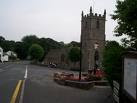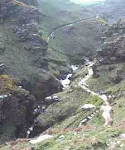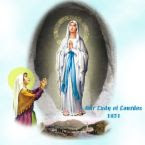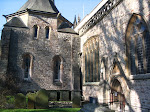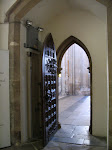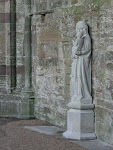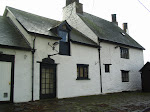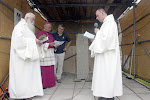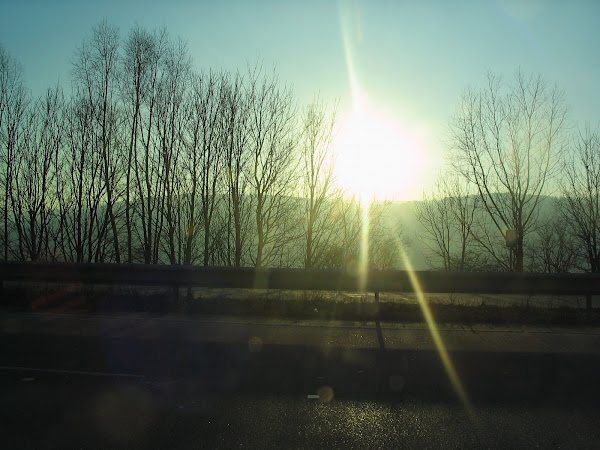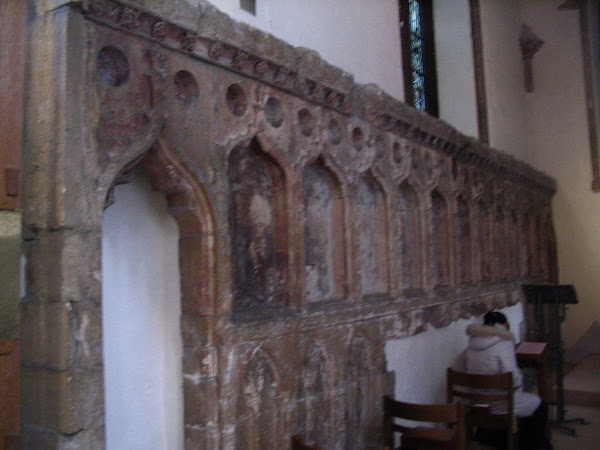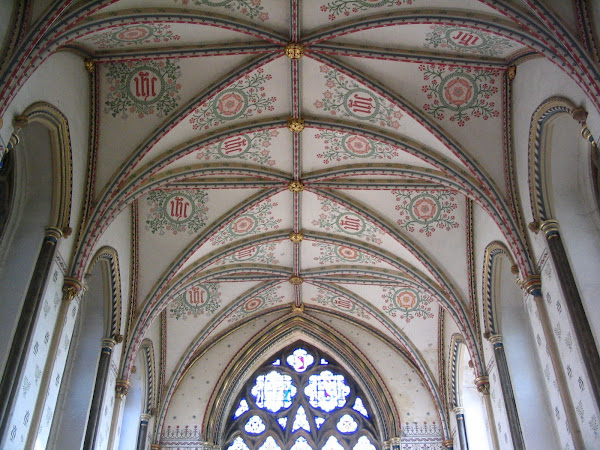The blessed saint, Margaret of Antioch patron of Childbirth, shown during her imprisonment before her execution for being a Christian and a consecrated Virgin.St Margaret was a popular Saint in the Middle Ages, but there seems little documented evidence, except tradition.








_________________________________________________________________________________________________________________________
Trellech Grange Trellech Grange 9Ecclesia Mainuon, EcclesiaTrylec, Lann Mainuon or Villa Guicon)The fact that this name (Villa Guicon (
Gwykon?Gwion?) seems to be Latin, may indicate, that like a lot of early settlements, it was based around a Roman villa. Possibly originally a local chieftain became a Christian, a room in the house being used as a meeting room, and then, during the Age of the Saints, became a monastery by the efforts of the holy priest Meinion.We need to take his name on trust. It seems to be the only thing we definitely know, because the settlement was named after him.
This settlement, still surrounded by farm buildings , one or two housing the monks who came to administrate here, is on high ground, and at the centre of one of the most fertile hundreds of land in Wales, that is the Hundred of Raglan. Everywhere are farm buildings and fields, sheep and cattle, and it seems in its heyday at Victorian times, it fed the whole of Tintern Abbey and the ancillary workers.
St MeinionIn later times it was a Grange on the site of the original monastery founded around 755 (although possibly even earlier) by a holy priest called Meinion. Meinion may have been one of the priests educated at the college at Caerwent ,or Michaelstone y Fedw (established in Roman times) who had come to this beautiful area to found a Llan.Of course, he may not have been a priest of course, but like St Gwynlliw of Newport, a chieftain who had turned to God . He was clearly well known as there is a mention of ‘Meinion’s Fields’ at Bedwellty and it is probable that he was a priest and an itinerant preacher, possibly even one of the Brycheiniog family come to do a Green Martyrdom and end his days in the little patch of heaven he had created,devoting himself to the praise and service of God..
The brushwood on the site would have been cleared. Then the all important wall built to divide the space and holy ground of heaven inside the monastery and the World outside the monastery and the ground sanctified by 40 days of fasting and constant prayer.
Finally the church would have been built and then the surrounding huts. It seems plain that there was a farm here, or that farming was begun here by the fledgeling community. Life no doubt continued in a quiet pastoral way for two centuries or so until the Saxon raids. There is a stream for water, water springs and a mill further down the valley (a short drive) where the Churchwarden low lives.
When the Normans came, the Grange was first selected as a grange for the Benedictine monks at Chepstow, who had the responsibility of appointing a priest , or sending one of their own who had been suitably qualified. For many years the monks of Chepstow had sway, being directed and empowered by William FitzOsbern. FitzOsbern’s time in Gwent was brief and he died in a battle in France.He was a steward of a more powerful family, but indispensable to William the Conqueror, who awarded him Chepstow and the means to build a castle to keep out the Welsh, and the Priory, who did his administration.
FitzOsbern and his family also helped the monks of Tintern to build the abbey. The Cistercian monks, when they came to Trellech (a short distance away 4 miles) were excellent farmers part of whose charism was, they did not mind hard physical work. These followers of Bernard of Clairvaux knew a great deal of food would be required for the monks now living at the abbey, and in fact, Trellech Grange produced most of the food for Tintern Abbey until Henry VIII took it from them.
Richard , Earl of Pembroke gives the Settlement to Tintern AbbeyIt was, in fact, Richard Earl of Pembroke, the powerful patron of Tintern Abbey who granted the Welsh chapel and the farmlands to the Abbey. They transformed the lands into one of their model farms or granges and the chapel they built here, was probably a rebuild of the Celtic site. Perhaps it was first a timber building if the original may have been mud and wattle, but when in 1224 William Marshall, the new Earl of Pembroken gave the monks ‘all things needful for the abbey and grange of Trellech, and stone for building, in the Forest of Wentwood’, the chapel was undoubtedly refashioned in stone- as was growing practice of the Cistercian site at the time. It can then be confidently assumed that the basic fabric of the church dates from the early 13th century.The Pembroke family were all interred in the abbey with monuments which have disappeared.
Original dedication to St Margaret of AntiochAccording to Professor David Williams offer such clues that there are in the records show the church to have been dedicated to St Margaret. St Margaret was a huge source of devotion back in the Middle Ages, and while documented historical evidence in the form of documents is thin, but St Margaret also had a shrine at the church in Caerwent, to which many people came on pilgrimage (from the notes in the ‘Lives of the Cambro British saints) A wall painting like the one above would commonly have appeared on the wall. Margaret (in Pisidia), virgin and martyr, is celebrated by the Roman Catholic and Anglican Churches on July 20 and July 17 in the Eastern Church.; Lack of written documentation meant she was declared apocryphal by Pope Gelasius I in 494, but devotion to her revived in the West with the Crusades and miracles occurred. She was reputed to have promised very powerful indulgences to those who wrote or read her life, or invoked her intercession; and these helped the spread of devotion to her.]
According to the ‘Golden Legend’, she was a native of Antioch, daughter of a pagan priest named Aedesius. She was scorned by her father for her Catholic Christian faith, and lived in the country with a foster-mother keeping sheep. Olybrius, the praeses orientis, offered her marriage at the price of her renunciation of Christianity. Upon her refusal, she was cruelly tortured, during which various miraculous incidents occurred.She bore her torture and died to this world bravely to be taken up to the martyrs. She is the patron saint of Childbirth by popular acclaim.
Unfortunately these were embroidered and more made up! She was martyred in 304 AD. St Margaret was the patron saint of pregnant women and greatly loved by women in childbirth. There were many Margaret dedications as Childbirth was a dangerous affair in the middle ages. She is also the patron of dying people and of people who have kidney problems, peasants, exiles and falsely accused people. So she had a great deal of scope to produce her miracles. The dedication to St Margaret would have reflected the New Norman order at the 1130’s the Norman saint having indicated this. There would have been an wall painting of St Christopher too, the saint who carried Christ in his arms. Legend dictated who ever looked at an image of him whislst dying would be granted eternal life.
Animal Husbandry and ExportThe monks took their produce down to Tintern. Other monks tended the sheep and spare produce which would keep. Like sheep were always herded down to Sudbury near Chepstow and here they set sail for Bristol and exported both the sheep, but especially the wool to the West Country and also further afield.
Even working in the field along side the labourers, at given times the bell would ring as it does in many Catholic areas today 12 noon the Angelus bell, during which the monks would recall the message of the Incarnation by an angel. Bell at 3 for nones, a short 15 minute series of prayers and psalms, 6pm Vespers or Evening prayers (called ‘Evensong’ its old name by Anglicans) and at 9pm Compline, when the monks would say their night prayers, finishing with the ‘Salve Regina’.Then they would be up for Mattins at 2am and again at 6 for Lauds, 8 for Mass and 9 for Prime. The Angelus would be followed by prayers and psalms called the ‘Terce’. The sounding of the church bell once to signal to all those in the field that the hour had come, meant they all turned towards the church at that time, and prayed the same prayers. The bell was a signal from heaven. It also rang at the moment of consecration during the Mass, and rang three times at 12 and six. This practice would have continued at Trellech Grange, keeping the monks and lay brothers and sisters in unity with their brothers at Tintern Abbey.___________________________________________________________






_________________________________________________________________________________________________________________
When Henry VIII took the church lands and sold them off at knockdown prices, often to the very agents he sent in to do the deed, the chapel became a parish church for the small farming area. Indeed by 1600 the Earls of Pembroke had once again become the patrons of the land around Trellech, perhaps part of their reward for not objecting to the ruination of what had been wonderful buildings at Tintern.No doubt one of the monks remained as parson at Trellech, after which the now Anglican diocese appointed vicars up to the present day. I am most grateful to the Vicar of Llanishen, the Reverend Derek Owen for making it possible for me to look around the beautiful chapel and Mrs Gwen Owen, who came out on a rainy day to take me round. It was very kind of them.
On the day I arrived, the church had just been brightly decked out for the Harvest Festival,the previous weekend and whilst some of the displays were not as fresh as on the previous Sunday, the effect was obvious. Coloured leaves and flowers were everywhere. The white font inside the church door was lively with flowers, and I was told children were beginning to return to the village, although incomers coming in and out meant there was a certain amount of instability. Because of its historic nature (it is the only Cistercian religious building of that mediaeval period still in use in Wales)CADW have insisted on expensive and authentic repairs, costing £60,000, impossible for the local community to find as they are not being allowed to carry out the work themselves. The deep suited instability of the community and lack of interest in local affairs is at the root of this, plus lottery funding all going to the Olympic Games. In the nineteenth century,(1848) the Duke of Beaufort owned all 1805 acres of Trellech Grange. There was stone quarrying there (indeed the church and local surrounding farm buildings seem to be made of the same stone) and possibly the stone for the abbey came from here.The Glebe alone was of 85 acres. Probably , as it was his church, and he appointed the vicars, he also carried out some renovations at this time.
The Stained Glass WindowThis, depicting the crucified Christ, and the dead soldier was designed by Queen Mary and chosen to commemorate the two local men who died in the Great War, John Edward Davies and Ralph Mortimer Bagley.
Trelleck Grange can be accessed by taking the Trellech Road to Llanishen and then taking a LEFT turn before driving up the hill on the other side. Curiously, the signpost to Trelleck Grange can only be observed driving the other way(!) so turn left at the small road after the white cottages. On the Left Hand Side.

























